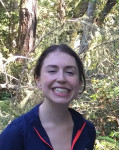Katie Klymko

Biographical Sketch
Katie Klymko received her PhD in 2018 from UC Berkeley where she worked on the statistical mechanics of non-equilibrium systems using computational and analytical techniques. She was a postdoc at LBL from October of 2018 through September of 2021, working on a range of topics including fluctuating hydrodynamics/finite volume methods for modeling mesoscale systems and more recently quantum computing algorithms. Her work in quantum computing has focused on the development of efficient methods for eigenvalue calculations in molecular systems as well as algorithms to explore thermodynamic properties. In October of 2021, she became a staff member at NERSC where she is working to integrate HPC and quantum computing.
Journal Articles
- Diana B Chamaki, Stuart Hadfield, Katherine Klymko, Bryan O'Gorman, and Norm M Tubman. Self-consistent Quantum Iteratively Sparsified Hamiltonian method (SQuISH): A new algorithm for efficient Hamiltonian simulation and compression. arXiv:2211.16522.
- Lindsay Bassman, Katherine Klymko, Diyi Liu, Norman M Tubman, and Wibe A. de Jong. Computing free energies with fluctuation relations on quantum computers, Physical Review Letters 129.13 (2022): 130603.
- Katherine Klymko, Carlos Mejuto-Zaera, Stephen J. Cotton, Filip Wudarski, Miroslav Urbanek, Diptarka Hait, Martin Head-Gordon, K. Birgitta Whaley, Jonathan Moussa, Nathan Wiebe, Wibe A. de Jong, and Norm M.Tubman. Real-time evolution for ultracompact Hamiltonian eigenstates on quantum hardware. PRX Quantum 3.2 (2022): 020323.
- Mekena Metcalf, Emma Stone, Katherine Klymko, Alexander F. Kemper, Mohan Sarovar, and Wibe A. de Jong. Quantum Markov chain Monte Carlo with digital dissipative dynamics on quantum computers. Quantum Science and Technology 7.2 (2022): 025017.
- Ahmad K. Omar, Katherine Klymko, Trevor GrandPre, Phillip L.Geissler, and John F. Brady. Tuning Nonequilibrium Phase Transitions with Inertia. The Journal of Chemical Physics 158.7 (2023).
- Kevin Luna, Katherine Klymko, and Johannes P. Blaschke. Accelerating GMRES with deep learning in real time. arXiv:2103.10975
- Ahmad K. Omar, Katherine Klymko, Trevor GrandPre, and Phillip L.Geissler. Phase diagram of active Brownian spheres: crystallization and the metastability of motility-induced phase separation. Physical Review Letters 126, no. 18 (2021): 188002. Editors’ Suggestion, Featured in Physics, Cover of PRL
- Daniel R. Ladiges, Andrew Nonaka, Katherine Klymko, Guy C. Moore, John B. Bell, Sean P. Carney, Alejandro L. Garcia, Sachin Natesh, and Aleksandar Donev. A Discrete ion stochastic continuum overdamped solvent algorithm for modeling electrolytes. Physical Review Fluids 6, (2021): 044309
- Trevor GrandPre, Katherine Klymko, Kranthi K. Mandadapu, and David T. Limmer. Entropy production fluctuations encode collective behavior in active matter. Physical Review E 103, no. 1 (2021): 012613
- Katherine Klymko, Sean. P. Carney, Andrew Nonaka, Alejandro L. Garcia, and John B. Bell. A low Mach number fluctuating hydrodynamics model for ionic liquids. Physical Review Fluids 5, no 9 (2020): 09803. Editors’ Suggestion
- Cory Hargus, Katherine Klymko, Jeffrey M. Epstein, and Kranthi K. Mandadapu. Time reversal symmetry breaking and odd viscosity in active fluids: Green-Kubo and NEMD results. The Journal of Chemical Physics 152, no. 20 (2020): 201102. Editors’ Suggestion
- J. M. Epstein, K. Klymko, K. K. Mandadapu. Statistical Mechanics of Transport Processes in Active Matter II: Equations of Hydrodynamics for Active Brownian Particles. The Journal of Chemical Physics 150.16 (2019): 164111.
- S. Whitelam, K. Klymko, D. Mandal. Phase separation and large deviations of lattice active matter. The Journal of Chemical Physics, 148 154902, 2018.
- K. Klymko, P.L. Geissler, J.P. Garrahan, S. Whitelam. Rare behavior of growth processes via umbrella sampling of trajectories. Physical Review E, 97, 032123, 2018.
- D. Mandal, K. Klymko, M.R. DeWeese. Entropy production and fluctuation theorems for active matter. Physical Review Letters, 119, 258001, 2017.
- K. Klymko, D. Mandal, K. K. Mandadapu. Statistical mechanics of transport processes in active fluids: Equations of hydrodynamics. The Journal of Chemical Physics, 147, 194109, 2017.
- K. Klymko, J.P. Garrahan, S. Whitelam. Similarity of ensembles of trajectories of reversible and irreversible growth processes. Physical Review E, 96, 042126, 2017.
- D. Mandal, K. Klymko, K. K. Mandadapu. Generalized hydrodynamics of active polar suspensions. arXiv:1706.02284, 2017.
- K. Klymko, P.L. Geissler, S. Whitelam. Microscopic origin and macroscopic implications of lane formation in mixtures of oppositely driven particles. Physical Review E, 94, 022608, 2016.
- D. M. Schauder, O. Kuybeda, J. Zhang, K. Klymko, A. Bartesaghi, M. J. Borgnia, M. L. Mayer, S. Subramaniam. P.N.A.S., 110, 5921-5926, 2013.
- G. Cecere, G.X.Y. Zheng, A.R. Mansisidor, K. Klymko, A. Grishok. Promoters recognized by forkhead proteins exist for individual 21U-RNAs. Mol. Cell, 47, 734-745, 2012.
- W.L. Miller, B. Bozorgui, K. Klymko, A. Cacciuto. Free energy of alternating two-component polymer brushes on cylindrical templates. The Journal of Chemical Physics 135, 244902, 2011.
- K. Klymko, A. Cacciuto. Free Energy of Multiple Overlapping Chains. Physical Review Letters 107, 278302, 2011.
Conference Papers
Jan Balewski, Daan Camps, Katherine Klymko, Andrew Tritt, "Efficient Quantum Counting and Quantum Content-Addressable Memory for DNA similarity", accepted at the IEEE23 quantum week conference, August 1, 2023,
We present QCAM, a quantum analogue of Content-Addressable Memory (CAM), useful for finding matches in two sequences of bit-strings. Our QCAM implementation takes advantage of Grover's search algorithm and proposes a highly-optimized quantum circuit implementation of the QCAM oracle. Our circuit construction uses the parallel uniformly controlled rotation gates, which were used in previous work to generate QBArt encodings. These circuits have a high degree of quantum parallelism which reduces their critical depth. The optimal number of repetitions of the Grover iterator used in QCAM depends on the number of true matches and hence is input dependent. We additionally propose a hardware-efficient implementation of the quantum counting algorithm (HEQC) that can infer the optimal number of Grover iterations from the measurement of a single observable. We demonstrate the QCAM application for computing the Jaccard similarity between two sets of k-mers obtained from two DNA sequences.







